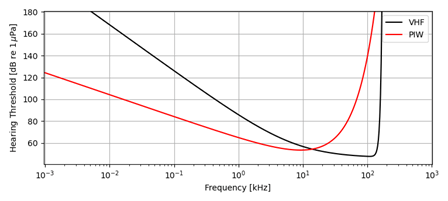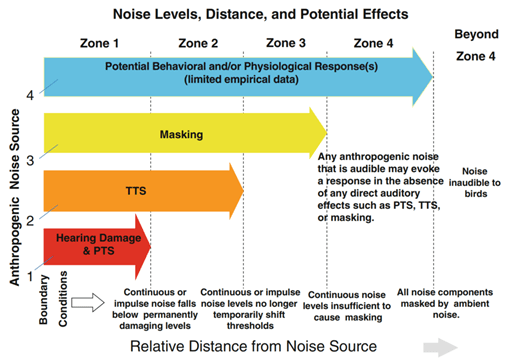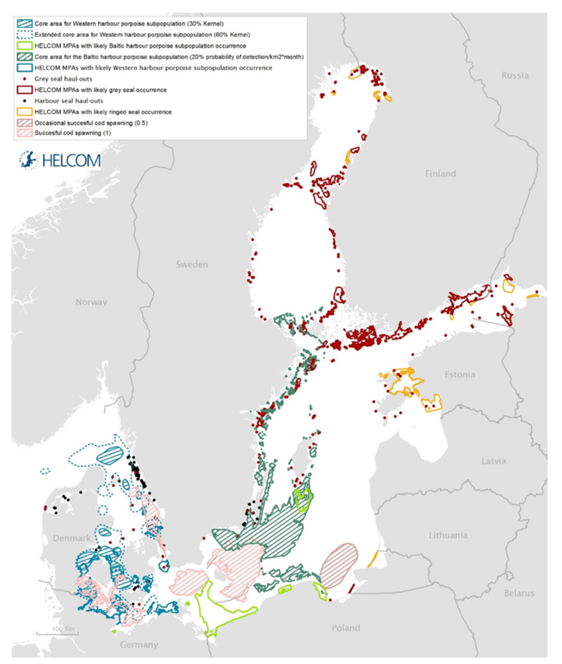Marine Life and Sound
Human action such as the emission of underwater noise has the potential to severely impact the marine environment. Consequently, the planning of research cruises includes these days an assessment of environmental impacts to avoid and mitigate negative effects on the marine flora and fauna.
Assessment for research cruises is advised by IAU (2001) and builds on OSPAR (2016) to reflect the Best Available Technique and Best Environmental Practices. Additionally, a broader assessment to check for secondary survey impacts covering the overall marine environment may have to be carried out.
As an outcome, safety distances to protected Natura 2000 areas have to be defined to avoid any negative impacts inside the protected areas.
For the definition of safety distances the biologic characteristics of animals and their hearing capabilities and sensitivities need to be evaluated.
Overall, reference has to be made in the assessment document to the following aspects
- Impacts of the noise emission
- Possible sources of noise emission
- Noise impact limits
- Mitigation
In general, the seismic and hydroacoustic measurements employed by MTU belong to the group of High Resolution Survey (HRS) methods being non-destructive.
For our research, these procedures currently only applied for Baltic Sea and North Sea research, but more countries request such evaluations and assessments.
Biology
Marine mammals and fish are to be considered for the impact assessment of underwater noise. So far, there is a very limited biologic data basis, noise sensitive species have been identified by Schack et al. (2019) including harbour porpoise, harbour seal, ringed seal, grey seal, cod, herring and sprat. Possible negative impacts on certain species depend on the survey area and both the frequency and strength of the noise as well as on the season due to periods of biological significance and migration patterns.
One of the most advanced studies on noise impact had beenpublished by Southall et al. (2007, 2019), which is guiding our evalations and suggestions for mitigation.

Median group audiograms depicting the hearing threshold at a broad frequency range for the groups of Very High Frequency Cetaceans (VHF) and Pinnipeds In Water (PIW, also commonly called Phocids Carnivores in Water: PCW) based on Southall et al. (2019).
In autumn e.g., the late nursing period of the harbour porpoise and the late mating/spawing period of cods occur. For our research in the Baltic Sea during student cruises on R/V Alkor, marine mammal species of harbour porpoises, grey and common seals are investigated in detail.
They belong to functional hearing groups of Very High Frequency Cetaceans (harbour propoise; VHF) and Pinnipeds In Water (grey and common seals; PIW or PCW; Southall et al., 2019). Highest hearing sensitivity for PIW is in the range of 10 kHz and for VHF at approx. 100 kHz, which is expressed as threshold of a proportion of 50%, where noise is heard, defined as sound intensity in dB (re 1 µPa peak).
Impact
The impacts of noise emission are characterized by permanent/temporary hearing damage (Permanent Threshold Shift: PTS; Temporary Threshold Shift: TTS), by masking and potential behavioral or physiological response with decreasing severity. For quantification, the unweighted peak sound pressure level [SPLuw,peak]= 1 dB (re 1µPa) and the weighted peak sound pressure level [SPLW,peak]= 1 dB (re 1µPa) are considered. Furthermore, the weighted and cumulative sound exposure level [SELW,cum] = 1 µPa2s (re 1 µPa2s) has to be taken into account. The onset limit of possible negative impacts for each zone is either SEL or SPL, whichever is lower.

Impact of noise emissions relative to the distance to the noise source taken from Dooling and Therrien (2012); PTS: Permanent Threshold Shift, TTS, Temporary Threshold Shift.
There is evidence that VHF show negative behavioral changes at SPL intensity levels of 80 dB (re 1 µPa peak) above the hearing sensitivity. Below 800 Hz the minimum threshold is 90 dB (re 1µPa peak) and the limit of 170 dB (re 1µPa peak) for behavioural change is considered. Harbour porpoises seem to show only low level TTS for small airguns and they are able to self-mitigate noise exposure at swimming speed (7.1 km/h), by changes of the head orientation and alteration of the hearing threshold by processes in the ear of the nervous system. And the recovery time from PTS and TTS is usually assumed to be 24h, but also much faster within 1-2 hours.
Reference Material
Noise sensitive areas resulting from the (seasonal) distribution of sensitive species in the Baltic Sea (from Schack et al., 2019).
References
IAU. (2001). Assessment of plans and projects significantly affecting Natura 2000 Sites - Methodological guidance on the provisions of Article 6(3) and (4) of the Habitats Directive 92/43/EEC (81 p.). Luxembourg: Impacts Assessment Unit, School of Planning Oxford Brookes University. (PDF)
OSPAR. (2016). OSPAR inventory of measures to mitigate the emission and environmental impact of underwater noise (72 p.). Convention for the Protection of the Marine Environment of the North East Atlantic. (PDF)
Schack, H., Ruiz, M., Andersson, M., & Zweifel, U. L. (2019). Noise sensitivity of animals in the Baltic Sea (Underwater noise No. 167) (46 p.). Helsinki, Finland: Helsinki Commission - HELCOM. (PDF)
Southall, B. L., Bowles, A. E., Ellison, W. T., Finneran, J. J., Gentry, R. L., Greene, C. R., et al. (2007). Marine Mammal Noise-Exposure Criteria: Initial Scientific Recommendations. Bioacoustics, 17(1–3), 273–275. https://doi.org/10.1080/09524622.2008.9753846
Southall, B. L., Finneran, J. J., Reichmuth, C., Nachtigall, P. E., Ketten, D. R., Bowles, A. E., et al. (2019). Marine Mammal Noise Exposure Criteria: Updated Scientific Recommendations for Residual Hearing Effects. Aquatic Mammals, 45(2), 125–232. https://doi.org/10.1578/AM.45.2.2019.125
